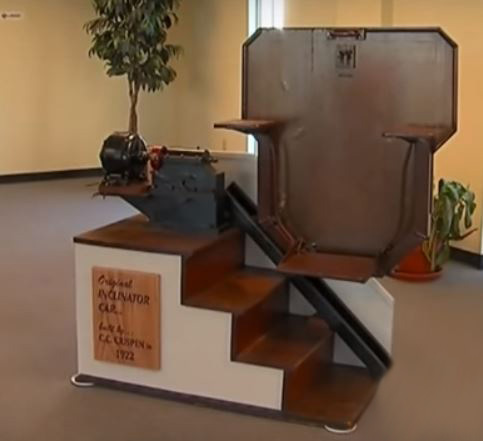For as long as there have been stairs, there will inevitably have been people who had trouble using them, due to injury, illness or infirmity.
Given mankind’s innate inventiveness, it seems likely that some way of overcoming stairs goes back to ancient history. It’s hard to believe those ingenious Egyptians didn’t come up with something for a frail Pharaoh – after all, they did build the pyramids!
 The earliest stairlift, or ‘chairlift’, was probably just that; several people lifting someone upstairs while he or she was seated on a chair. But the first evidence of any kind of purpose-built mechanical contraption comes from eminent British historian Dr David Starkey. While trawling through a long and detailed of King Henry VIII’s possessions, compiled around the time of his death in 1547, he made a remarkable discovery.
The earliest stairlift, or ‘chairlift’, was probably just that; several people lifting someone upstairs while he or she was seated on a chair. But the first evidence of any kind of purpose-built mechanical contraption comes from eminent British historian Dr David Starkey. While trawling through a long and detailed of King Henry VIII’s possessions, compiled around the time of his death in 1547, he made a remarkable discovery.
The list made reference to “a chair... that goeth up and down” which was in use at Whitehall Palace in London. Dr Starkey believes it was used to move the ailing King up and down a 20ft staircase at the palace, with servants hauling on a block and tackle system similar to that on the king’s famous warship Mary Rose. He also found reference to the King owning three primitive wheelchairs to help him move around his palaces.
Dr Starkey cited the finds as evidence that Henry was barely able to walk towards the end of his life. Despite being vigorous in his youth, spending much of his time riding, hunting and travelling the country, Henry’s health declined rapidly in later life. He suffered a serious leg injury while jousting in 1536 which never properly healed and significantly hindered his mobility from then on.
Unable to exercise, but still enjoying huge royal banquets, his weight ballooned to around 30 stone, his obesity exacerbating his ulcerated leg wound and making him virtually immobile without help from servants. Portraits of the King in his later years show him to be bloated and using a strong wooden staff for support. He would have found climbing stairs almost impossible, argues Dr Starkey, so the invention of the stairlift was born out of necessity.
The first-known registered design for a rudimentary stairlift relates to one Frederick Muffett, a “carpenter and beerhouse keeper” of Royal Tunbridge Wells, England. He is credited with registering a workable design for a stairlift in the late 1800s, when he patented an “invalid chair with tramway for use on staircases”. It was a direct predecessor of today’s modern rail and carriage stairlifts.
The first commercially successful stairlifts were devised and marketed by American self-taught engineer and entrepreneur C.C. Crispen, in the 1920s. While visiting a Pennsylvania neighbour who was confined to an upstairs bedroom through illness, the resourceful Crispen began thinking up ways to overcome the stairs. Within a few days he had the outline of a US Patent for his invention, which he named the “Inclin-ator” (pictured above), conveying the notion of an elevator for use on an incline.
His concept used a folding wooden carriage which was mounted onto a steel rail fixed to the staircase. An electric motor drawing power from the normal domestic supply moved the platform on rollers up and down the rail, controlled by the user in the carriage or by switches at the top and bottom of the stairs.
After a series of prototypes, Crispen perfected his design and formed The Inclinator Company of America, which is still going today. In 1924 he was invited to display his invention in the Philadelphia Electric Company’s showroom and this, combined with print advertising, saw sales begin to take off. Polio was widespread at the time, leaving many people with permanent disabilities, and while these first home stairlifts were expensive luxury items, there was a pool of customers for them. Early buyers included fellow inventor Thomas Edison, business magnate John D, Rockerfeller, Hollywood star Groucho Marx and car manufacturers Henry Ford and Walther Chrysler.
Crispen’s invention established the basic principle of an electric-powered carriage moving up and down a rail fixed to the staircase, controlled by the user. While there have been countless developments and refinements in the decades since, that basic principle still applies to almost all modern stairlifts.
Design and manufacturing advances, combined with a growth in the number of competing suppliers, mean modern stairlifts are now an affordable commodity for almost anyone who struggles to use the stairs. With people living longer than ever before and keen to stay living independently in their own homes, the demand for stairlifts has never been stronger.
To learn how an Acorn Stairlift could transform your quality of life, give us a call today on 0808 223 4871 or click on the green ‘Quick Free Quote’ button at the top right of this page.
